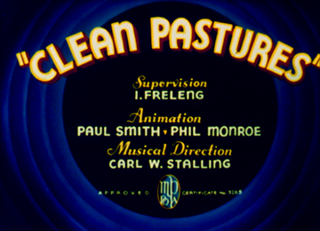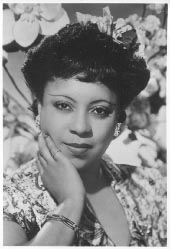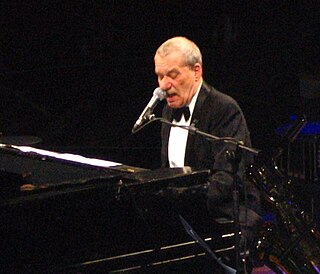
Cabaret is a form of theatrical entertainment featuring music, song, dance, recitation, or drama. It is mainly distinguished by the performance venue, which might be a pub, a restaurant or a nightclub with a stage for performances. The audience, often dining or drinking, does not typically dance but usually sits at tables. Performances are usually introduced by a master of ceremonies or MC. The entertainment, as done by an ensemble of actors and according to its European origins, is often oriented towards adult audiences and of a clearly underground nature. In the United States striptease, burlesque, drag shows, or a solo vocalist with a pianist, as well as the venues which offer this entertainment, are often advertised as cabarets.

The Jazz Age was a period in the 1920s and 1930s in which jazz music and dance styles rapidly gained nationwide popularity in the United States. The Jazz Age's cultural repercussions were primarily felt in the United States, the birthplace of jazz. Originating in New Orleans as a fusion of African and European music, jazz played a significant part in wider cultural changes in this period, and its influence on pop culture continued long afterward. The Jazz Age is often referred to in conjunction with the Roaring Twenties, and in the United States it overlapped in significant cross-cultural ways with the Prohibition Era. The movement was largely affected by the introduction of radios nationwide. During this time, the Jazz Age was intertwined with the developing cultures of young people, women, and African Americans. The movement also helped start the beginning of the European Jazz movement. American author F. Scott Fitzgerald is widely credited with coining the term, first using it in his 1922 short story collection titled Tales of the Jazz Age.

Mamie Smith was an American vaudeville singer, dancer, pianist and actress. As a vaudeville singer she performed in various styles, including jazz and blues. In 1920, she entered blues history as the first African-American artist to make vocal blues recordings. Willie "The Lion" Smith described the background of that recording in his autobiography, Music on My Mind (1964).

Josephine Baker was an American-born French entertainer, activist and French Resistance agent. Her career was centered primarily in Europe, mostly in her adopted France. During her early career she was renowned as a dancer, and was among the most celebrated performers to headline the revues of the Folies Bergère in Paris. Her performance in the revue Un vent de folie in 1927 caused a sensation in Paris. Her costume, consisting of only a girdle of artificial bananas, became her most iconic image and a symbol of the Jazz Age and the 1920s.

The Apollo Theater is a music hall located at 253 West 125th Street between Adam Clayton Powell Jr. Boulevard and Frederick Douglass Boulevard in the Harlem neighborhood of Manhattan, New York City. It is a noted venue for African-American performers, and is the home of Showtime at the Apollo, a nationally syndicated television variety show which showcased new talent, from 1987 to 2008, encompassing 1,093 episodes; the show was rebooted in 2018.

The Cotton Club was a New York City nightclub located in Harlem on 142nd Street and Lenox Avenue from 1923 to 1935, then briefly in the midtown Theater District from 1936 to 1940. The club operated most notably during the United States' era of Prohibition. The club was a whites-only establishment, but featured many of the most popular black entertainers of the era, including musicians Fletcher Henderson, Duke Ellington, Jimmie Lunceford, Chick Webb, Louis Armstrong, Count Basie, Fats Waller, Willie Bryant; vocalists Adelaide Hall, Ethel Waters, Cab Calloway, Bessie Smith, Aida Ward, Avon Long, the Dandridge Sisters, the Will Vodery Choir, The Mills Brothers, Nina Mae McKinney, Billie Holiday, Lena Horne; and dancers Bill Robinson, The Nicholas Brothers, Charles 'Honi' Coles, Leonard Reed, Stepin Fetchit, the Berry Brothers, The Four Step Brothers, Jeni Le Gon and Earl Snakehips Tucker.

The black bottom is a dance which became popular in the 1920s—the Roaring Twenties, also known as the Jazz Age, and the era of the flapper. It was danced solo or by couples.
Theatre Owners Booking Association, or T.O.B.A., was the vaudeville circuit for African American performers in the 1920s. The theaters mostly had white owners and booked jazz and blues musicians and singers, comedians, and other performers, including the classically trained, such as operatic soprano Sissieretta Jones, known as "The Black Patti", for black audiences.

Clean Pastures is a 1937 Merrie Melodies cartoon directed by Friz Freleng.

Adelaide Louise Hall was an American-born UK-based jazz singer and entertainer. Hall's long career spanned more than 70 years from 1921 until her death and she was a major figure in the Harlem Renaissance. Hall entered the Guinness Book of World Records in 2003 as the world's most enduring recording artist having released material over eight consecutive decades. She performed with major artists such as Art Tatum Ethel Waters, Josephine Baker, Louis Armstrong, Lena Horne, Cab Calloway, Fela Sowande Rudy Vallee and Jools Holland, and recorded as a jazz singer with Duke Ellington and with Fats Waller.

Shuffle Along is a musical with music and lyrics by Noble Sissle and Eubie Blake, and a thin revue-style connecting plot about a mayoral race, written by Flournoy Miller and Aubrey Lyles.
African-American musical theater relates to the historic musical theater of the African American community, particularly prominent in New York City during the first half of the 20th Century.
The expression Italian popular music refers to the musical output which is not usually considered academic or Classical music but rather have its roots in the popular traditions, and it may be defined in two ways: it can either be defined in terms of the current geographical location of the Italian Republic with the exceptions of the Germanic South Tyrol and the eastern portion of Friuli Venezia Giulia; alternatively it can be defined as the music produced by all those people who consider themselves as Italians and openly or implicitly refer to this belief. Both these two definitions are very loose: due to the complex political history of the Italian Peninsula and the different independent political states, cultural and linguistic traditions which sprang within them, it is rather difficult to define what may be considered to be truly Italian. Since before the formation of a unified educational system and the spread of information through the radio and the press during the twenties, all the different cultural and linguistic groups within the country were independent from one another, and a unified Italian Country was still only a political or ideological concept far from the daily life.
The Harlem Renaissance was an intellectual, social, and artistic explosion centered in Harlem, New York, spanning the 1920s. At the time, it was known as the "New Negro Movement", named after The New Negro, a 1925 anthology edited by Alain Locke. The movement also included the new African-American cultural expressions across the urban areas in the Northeast and Midwest United States affected by the Great Migration, of which Harlem was the largest.
Jimmy Mordecai also known as James Mordecai was a Harlem-based jazz tap dancer in the 1920s and 1930s. James Mordecai was born in New York City in 1905. His father was Samuel Mordecai and his mother Sara Cunningham immigrated into these United States from British West Indies in 1901 through Cuba. He was in the cast of a 1924 touring show called "Cotton Land," with music by James P. Johnson. He was a member of a popular dance trio, Wells, Mordecai and Taylor, with whom he performed at the Cotton Club in 1930 with a Duke Ellington revue called "Brown Sugar ." In that revue, he danced with Cora LaRedd, a renowned tap dancer active at the time.

Cabin in the Sky is a musical with music by Vernon Duke, book by Lynn Root, and lyrics by John Latouche. The musical opened on Broadway in 1940. The show is described as a "parable of Southern Negro Life with echoes of Ferenc Molnár's Liliom and Marc Connelly's The Green Pastures."

The city of Paris has been an important center for European music since the Middle Ages. It was noted for its choral music in the 12th century, for its role in the development of ballet during the Renaissance, in the 19th century it became famous for its music halls and cabarets, and in the 20th century for the first performances of the Ballets Russes, its jazz clubs, and its part in the development of serial music. Paris has been home to many important composers, to name a few: Jean-Baptiste Lully, Jean-Philippe Rameau, Christoph Willibald Gluck, Niccolò Piccinni, Frédéric Chopin, Franz Liszt, Jacques Offenbach, Georges Bizet, Claude Debussy, Maurice Ravel, Hector Berlioz, Paul Dukas, Gabriel Fauré, César Franck, Charles Gounod, Jules Massenet, Vincent d'Indy, Camille Saint-Saëns, Erik Satie, Igor Stravinsky, Sidney Bechet...

Shuffle Along, or, the Making of the Musical Sensation of 1921 and All That Followed is a musical with a score by Eubie Blake and Noble Sissle and a libretto by George C. Wolfe, based on the original book of the 1921 musical revue Shuffle Along, by Flournoy Miller and Aubrey Lyles. The story focuses on the challenges of mounting the original production of Shuffle Along and its effect on Broadway and race relations.














